文章目录
- 11-1 算法性能评估
- 1)时间复杂度
- 1.大O表示法
- 只关注循环次数多的代码
- 选大量级
- 嵌套循环要乘积
- 常见复杂度分析
- 2)空间复杂度
- 11-2 数组与列表
- 1)什么是数组?
- 插入操作
- 删除操作
- 2)改进数组
- 3)C 语言用结构体表示 List 对象
- Append
- Insert
- pop
- remove
- 11-3 队列
- 知识前提
- 队列二要素:入队,出队
- 顺序队列
- 基础队列
- 加入数据迁移的队列
- 链式队列
- 循环队列
- 阻塞队列
- 并发队列
- 11-4 堆栈
- 引言
- 顺序栈
- 链式栈
- 11-5 链表
- 链表与数组的区别
- 单链表与循环链表
- 双向链表
- 再次比较数组和链表
- 11-6 二叉树
- 树的基本术语
- 二叉树
- 二叉树的遍历
- 二叉查找树
- 查找
- 插入
- 删除
- 重要特性
11-1 算法性能评估
帖子:https://ceshiren.com/t/topic/10867
1)时间复杂度
- 规模:不同量级有不同的速度,比如水 vs 水杯: 水;规模大小对算法至关重要
- 测试环境:在不同测试环境,速度也不同,比如手机 vs 电脑: 电脑;运行环境:环境的快慢对算法至关重要
1.大O表示法
def tmp(n):
add = 0
for i in range(n):
add += 1
return add
运行 T(n) = (2n+1) * unit
算法的运行时间与数据规模成正比
T(n) = O(f(n)) O表示 T(n)与f(n)成正比
O表示渐近时间复杂度
表示代码执行时间随数据规模增长的变化趋势
当n很大时,低阶、常量、系数三部分并不左右增长趋势,所以都可以忽略,就可以记为:T(n) = O(n); T(n) = O(n2)
只关注循环次数多的代码
def tmp(n):
add = 0
for i in range(n):
add += i
return add
O(n)
选大量级
def tmp(n):
for i in range(999):
print(123)
for i in range(n):
print(1)
for i in range(n):
for j in range(n):
print(2)
O(n2)
嵌套循环要乘积
def tmp(n):
for i in range(n):
a(i)
def a(n):
for i in range(n):
print('c')
O(n2)
常见复杂度分析
- 非多项式量级(过于低效) : O(2n) 和 O(n!)。
- 多项式量级:O(1), O(logn), O(n), O(nlogn), O(nk)
O(1)
a=2
b=3
d=4
O(logn)
def tmp(n):
i = 1
while i < n :
i = i * 2
i = 20,21, 22, 23…2x
退出循环的条件是 : 2x = n ,即 x = log2n,时间复杂度为 O(log2n)
def tmp(n):
i = 1
while i < n :
i = i * 3
log3n 就等于 log32 * log3n,所以 O(log3n) = O(C * log2n),其中 C=log32 是一个常量。基于我们前面的一个理论:在采用大 O 标记复杂度的时候,可以忽略系数,即 O(Cf(n)) = O(f(n))。所以,O(log2n) 就等于 O(log3n)。因此,在对数阶时间复杂度的表示方法里,我们忽略对数的“底”,统一表示为 O(logn)
O(m+n)、O(m*n)
def tmp(m, n):
for i in range(m):
print(1)
for i in range(n):
print(2)
2)空间复杂度
- 渐进时间复杂度:表示算法的执行时间与数据规模之间的增长关系。
- 渐进空间复杂度(asymptotic space complexity):表示算法的存储空间与数据规模之间的增长关系。
def tmp(n):
a = [1]*n
for i in a:
print(i)
空间复杂度是: O(n)
11-2 数组与列表
课程贴:https://ceshiren.com/t/topic/10895
1)什么是数组?
数组是线性表数据结构。用连续的内存空间存储相同类型的数据。
- 线性表:线性表是数据排成一条线一样的结构。每个线性表上的数据最多只有前和后两个方向。
包括:数组,链表、队列、栈。 - 非线性表:数据之间并不是简单的前后关系。
包括:二叉树、堆、图等。 - 连续的内存空间和相同类型的数据:使数组支持“随机访问”。但在数组中删除、插入数据时,需要做大量的数据搬移工作。
数组如何实现随机访问?
C 语言代码: int[] tmp = new int[4],这个数组在内存中连续放置:
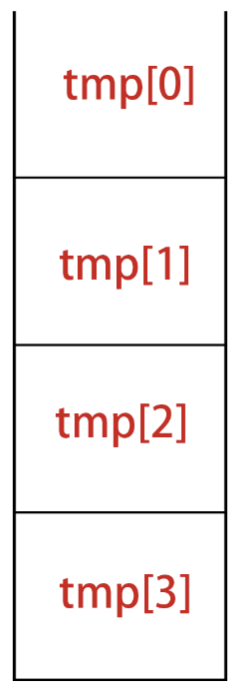
插入操作
- 在数组末尾插入元素,不需要移动数据,时间复杂度为 O(1)。
- 在数组开头插入元素,那所有的数据都需要依次往后移动一位,所以最坏时间复杂度是 O(n)。
- 假设每个位置插入元素概率相同,平均情况时间复杂度为 (1+2+…n)/n=O(n)。

如果元素无序,可直接换位:
删除操作
- 删除数组末尾数据:则最好情况时间复杂度为 O(1);
- 删除开头的数据:则最坏情况时间复杂度为 O(n);
- 平均情况时间复杂度也为 O(n)。
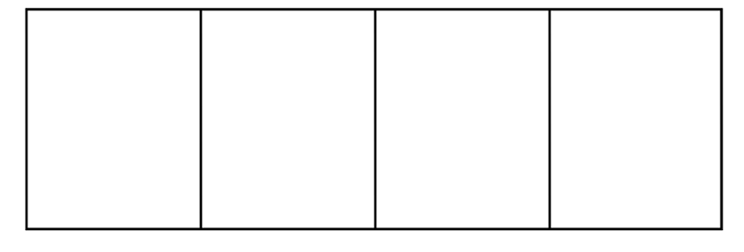
预删除思想:JVM 标记清除垃圾回收算法
2)改进数组
编程语言封装了数组,比如 Java 的 ArrayList, Python 的 List ,可实现自动扩容,多种数据类型组合。
如果你是底层工程师,需要极致的比如开发网络框架,性能的优化需要做到极致,这个时候数组就会优于容器,成为首选。
class Array:
def __init__(self, capacity) -> None:
self.data = [-1]*capacity
# 记录存了多少数据
self.count = 0
# 数组容量
self.n = capacity
def insert(self, location, value):
if self.n == self.count:
return False
if location < 0 or location > self.count:
return False
for i in range(self.count, location, -1):
self.data[i] = self.data[i-1]
self.data[location] = value
self.count += 1
return True
def find(self, location):
if location < 0 or location >= self.count:
# -1代表没找到
return -1
return self.data[location]
def delete(self, location):
if location < 0 or location >= self.count:
return False
for i in range(location + 1, self.count):
self.data[i-1] = self.data[i]
self.count -= 1
return True
def test_demo():
array = Array(5)
array.insert(0, 1)
array.insert(0, 2)
array.insert(1, 3)
array.insert(2, 4)
array.insert(4, 5)
# 判断插入不成功
assert not array.insert(0, 100)
assert array.find(0) == 2
assert array.find(2) == 4
assert array.find(4) == 5
assert array.find(10) == -1
assert array.count == 5
removed = array.delete(4)
assert removed
assert array.find(4) == -1
removed = array.delete(10)
assert not removed
# 2 3 4 1 5
assert array.data == [2, 3, 4, 1, 5]
if __name__ == '__main__':
test_demo()
- delete
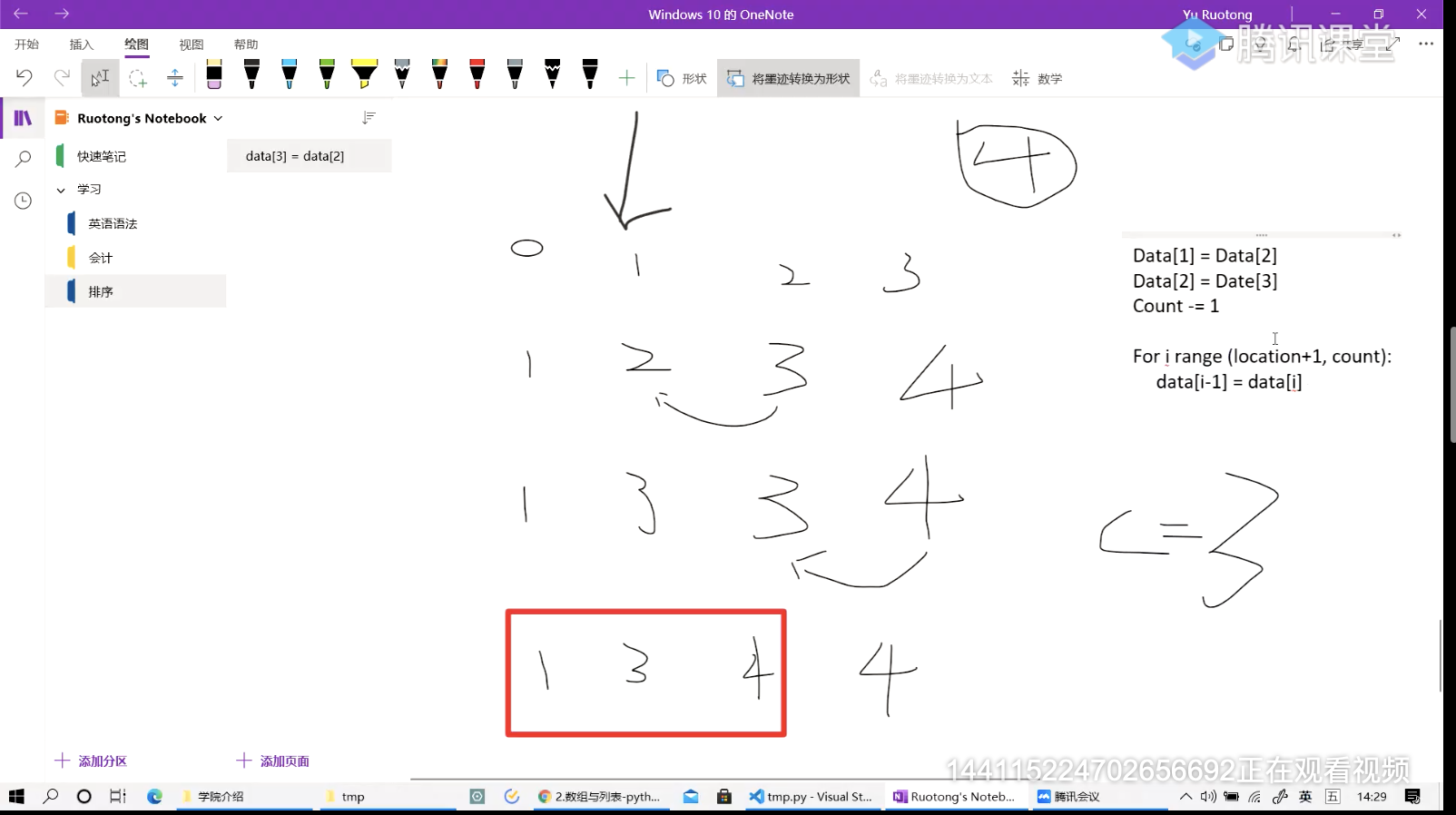
python list 源码解析
本篇文章描述了 CPython 中 list 的实现方式。
3)C 语言用结构体表示 List 对象
C 语言使用结构体实现 list 对象,结构体代码如下。
typedef struct {
PyObject_VAR_HEAD
PyObject **ob_item; //指向 list 中的对象
Py_ssize_t allocated; //内存分配的插槽
} PyListObject;
List 初始化
以 I = [] 为例
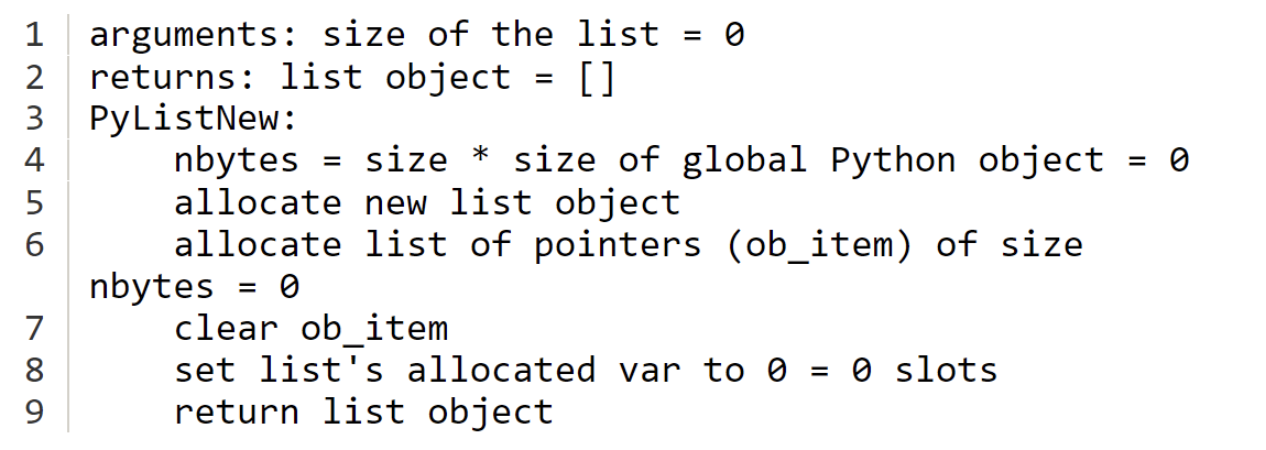
list 的数量是指 len(l)。分配的槽位数量是指在内存中实际分配的数量。通常情况,内存中分配的数量要大于 list 的数量。这是为了当添加新元素时,避免内存再分配。
Append
当运行l.append(1)时, CPython 将调用app1():

list_resize() 会故意分配更多的内存,避免被多次调用。分配内存大小增加:0, 4, 8, 16, 25, 35, 46, 58, 72, 88, …

第一次分配了 4 个槽位,I[0] 指向了数字对象 1 。正方形虚线表示未使用过的槽位。追加操作的均摊复杂度为 O(1) 。
均摊时间复杂度是平均时间复杂度的一种,是一种简化的计算方法。
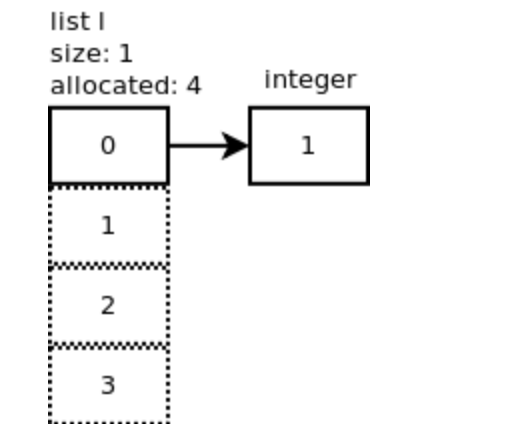
继续追加元素:l.append(2)。调用 list_resize 实现 n + 1 = 2。由于分配了四个空间,不需要分配内存。当再向列表追加两个数字时,l.append(3), l.append(4),如下图如示:
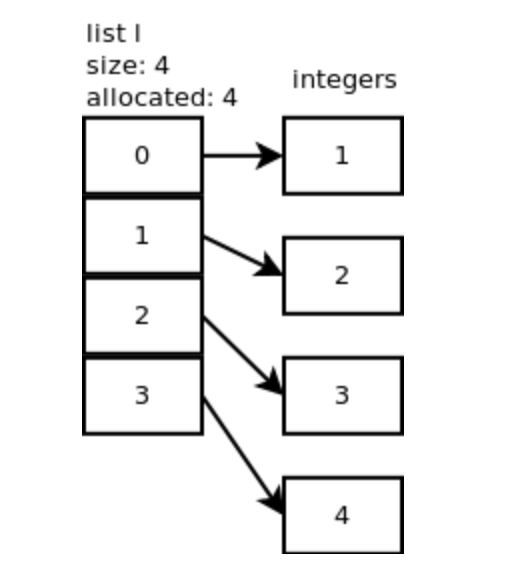
Insert
在位置 1 插入整型 5 ,即调用 python 的 l.insert(1, 5) 。CPython 会调用 ins1() :
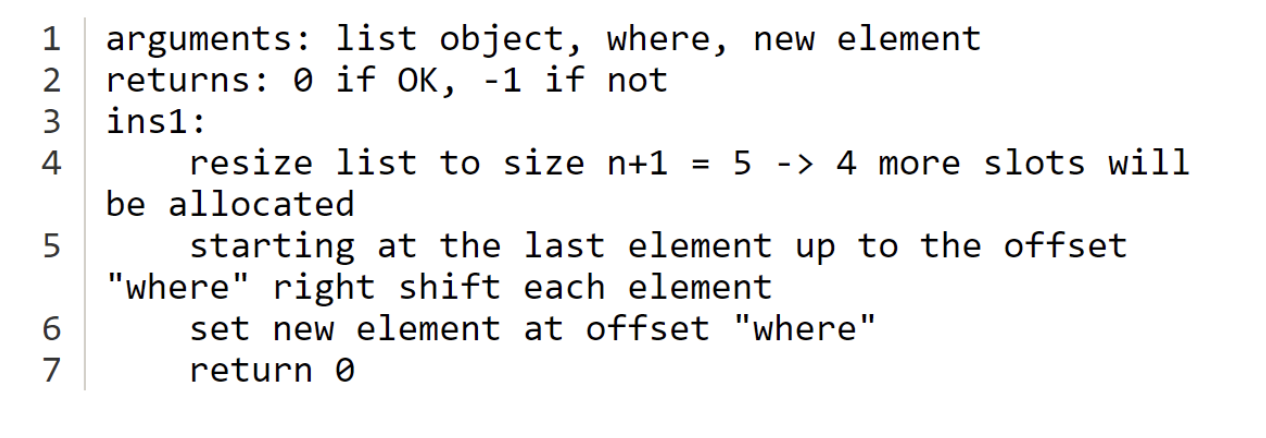
插入操作需要将剩余元素向右迁移:
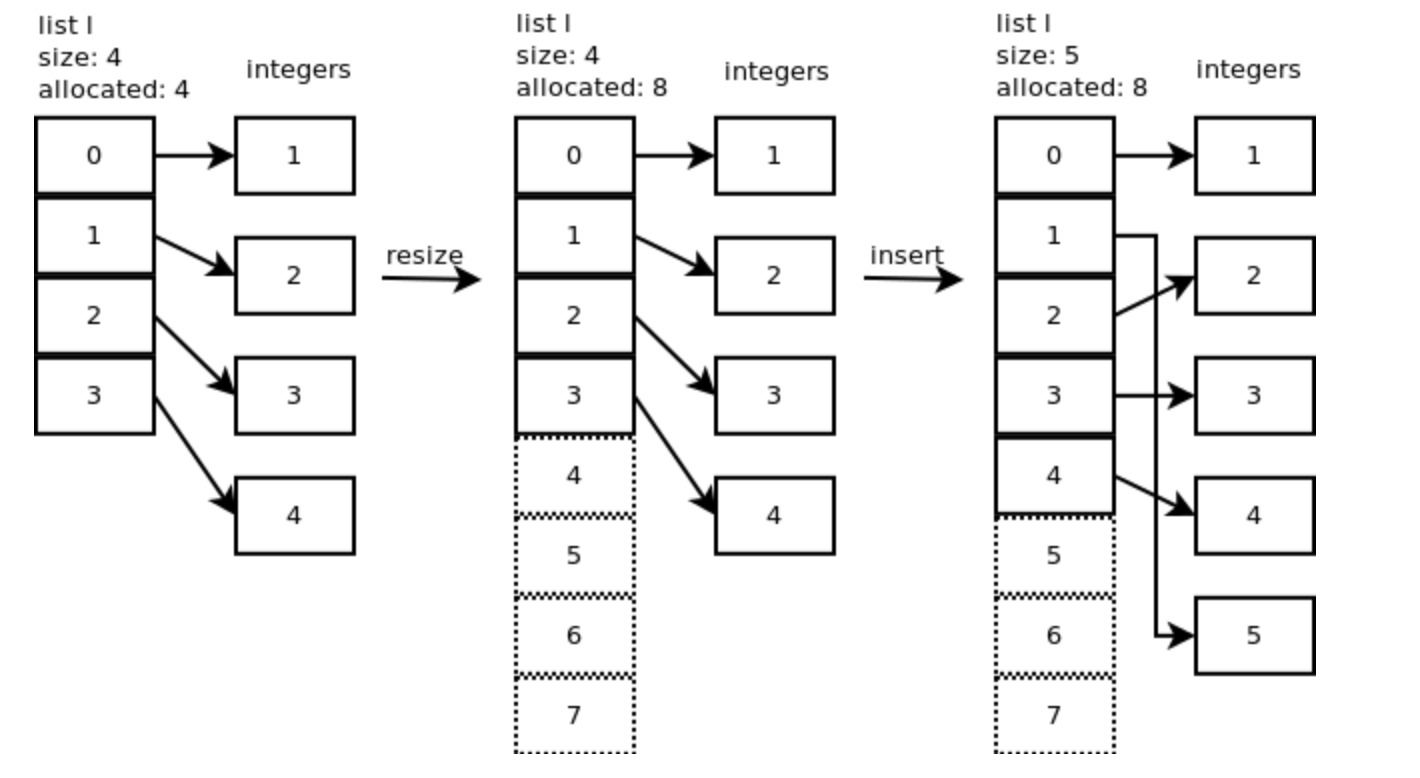
上图虚线表示未使用的槽位(slots),分配了 8 个槽位,但 list 的长度只有 5 。 insert 的时间复杂度为 O(n)。
pop
弹出列表的最后一个元素使用 l.pop(),CPython 使用 listpop() 实现这个过程。如果新内存大小少于分配大小的一半, listpop() 将调用 list_resize 减少 list 内存。

Pop 的时间复杂度是 O(1)。
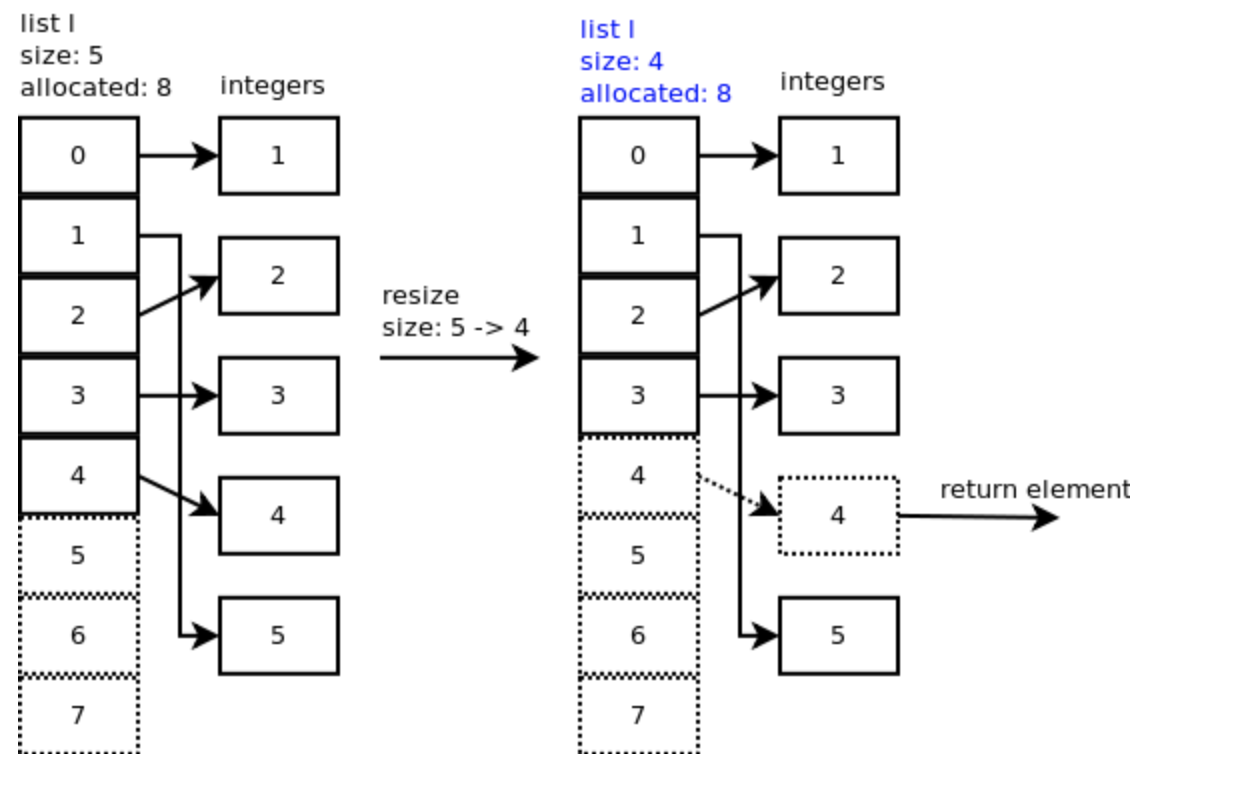
注意,此时槽位 4 仍然指向整型 4 ,但是 list 的大小却是 4 。只有 pop 更多的元素才能调用 list_resize() 减少内存,如果再 pop 一个元素, size - 1 = 4 - 3 = 3, 3 小于分配槽位的一半 8/2 = 4 。所以 list 收缩到 6 个槽位, list 的大小为 3 。虽然槽位 3 和 4 依旧指向整型对象,但是整体大小变成了 3 。
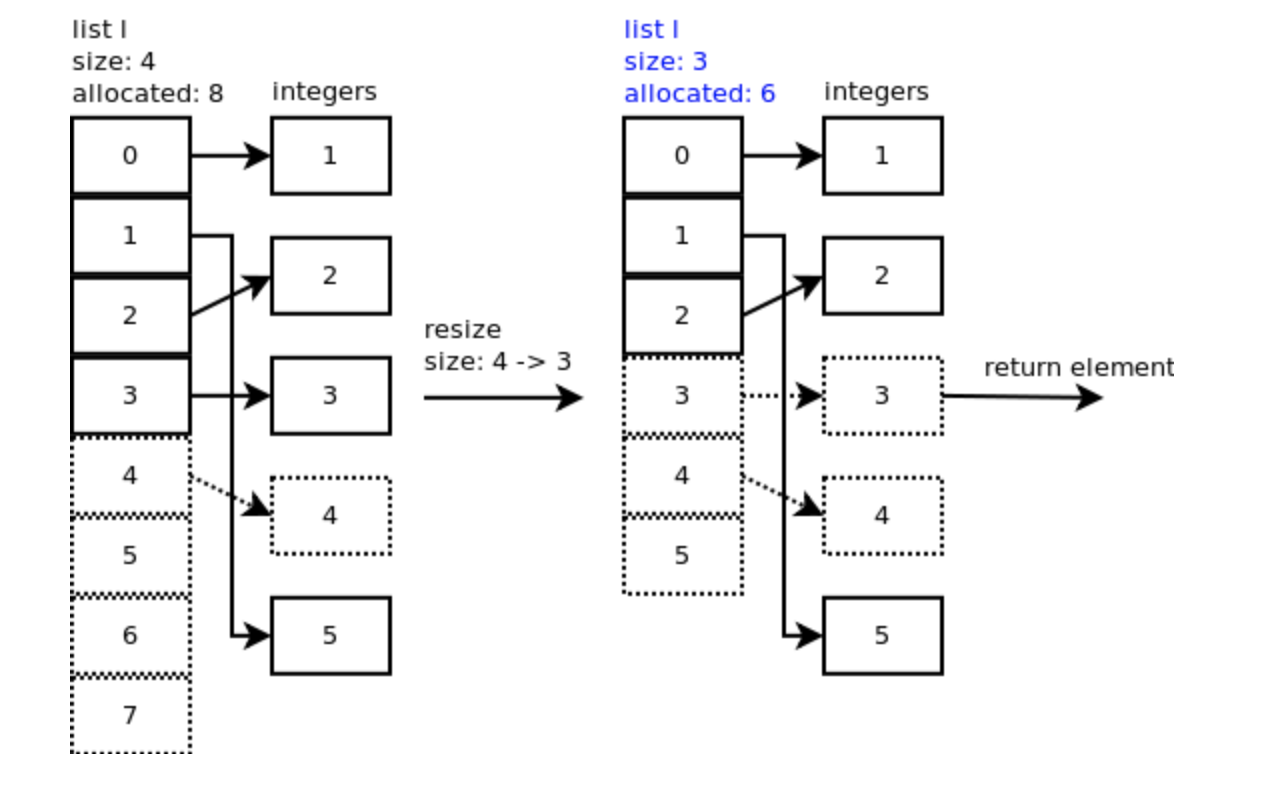
remove
Python 可以用 remove 删除指定元素:l.remove(5)。此时将调用 listremove() 。

CPython 调用 list_ass_slice() 函数对列表进行切分并删除元素。当在位置 1 移除元素 5 时,低偏移(low offset)是 1 ,高偏移(high offset)是 2 :

remove 时间复杂度是 O(n)。
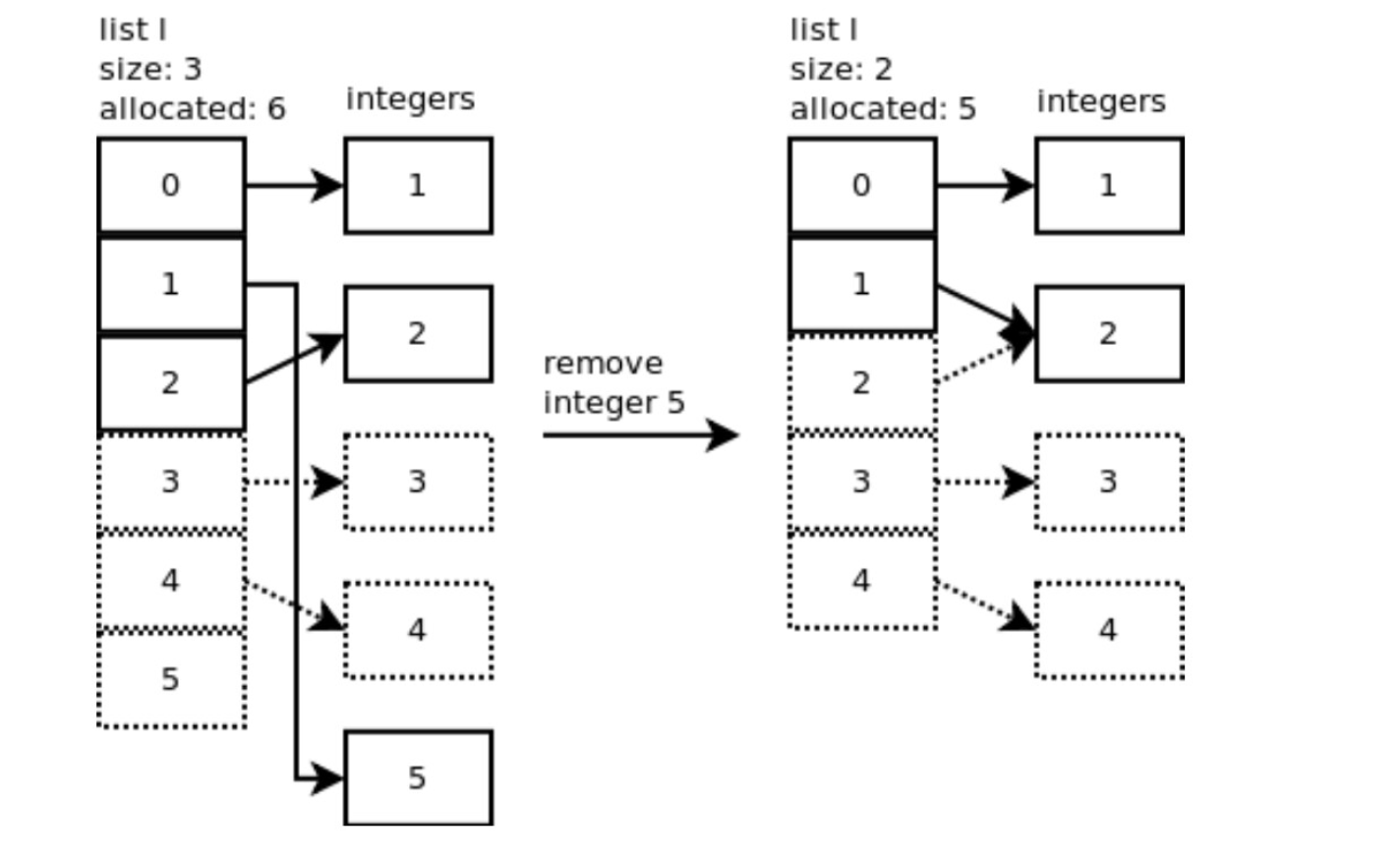
文章参考:
http://www.laurentluce.com/posts/python-list-implementation/
11-3 队列
课程贴:https://ceshiren.com/t/topic/11369
知识前提
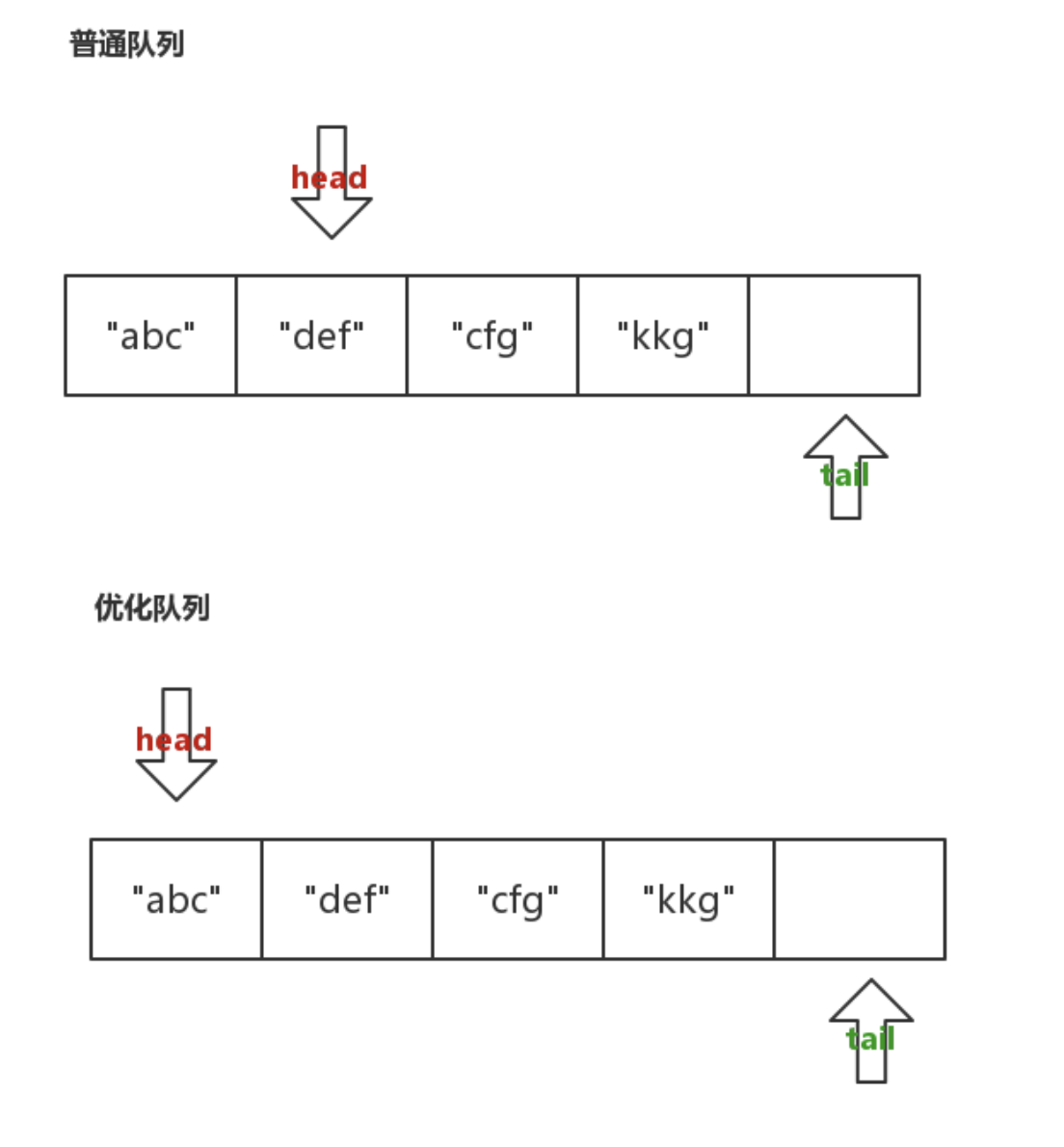
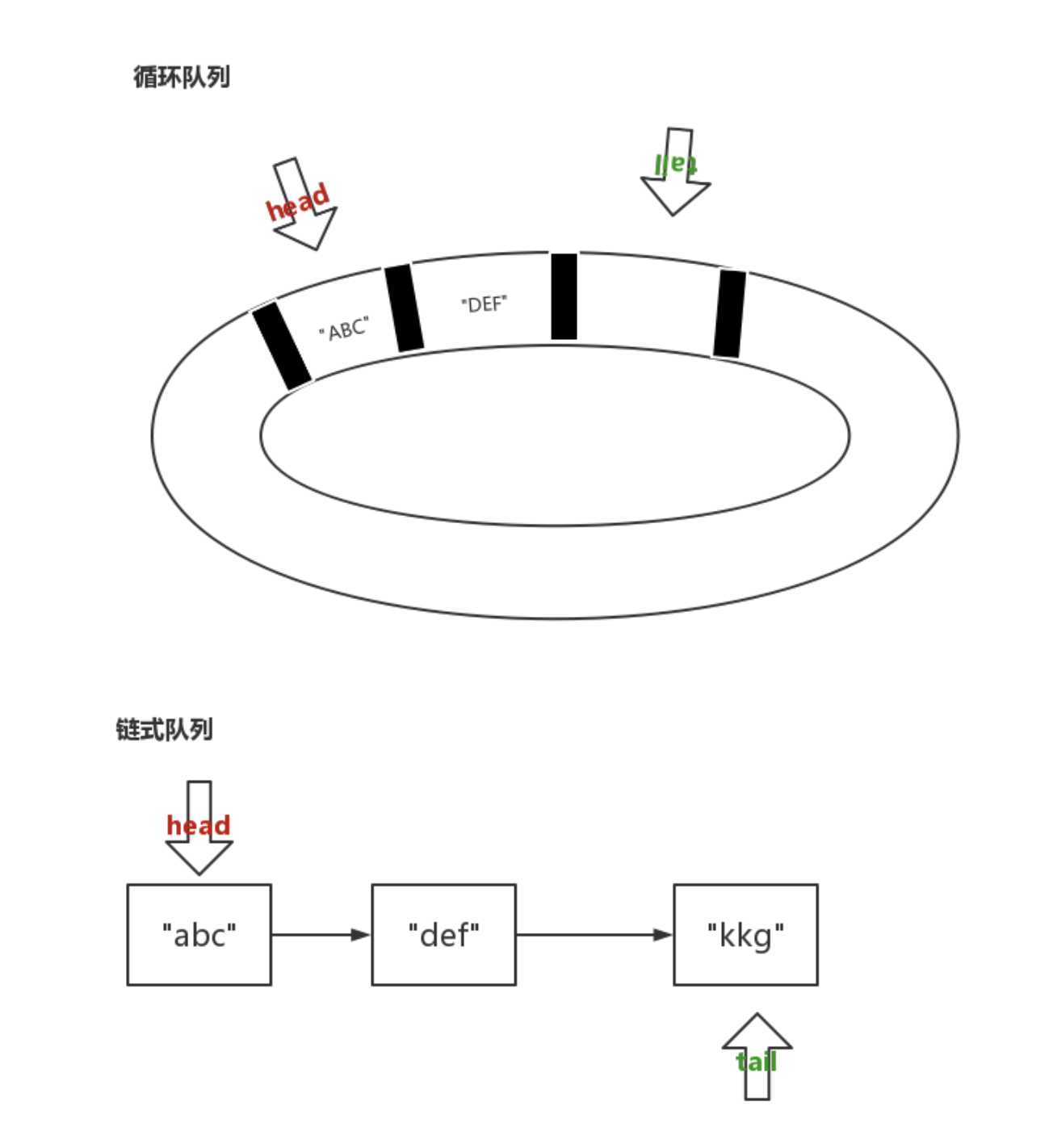
利用数组实现
普通队列
优化队列
循环队列
利于优化
利用链表实现
普通链表队列
不易优化
队列二要素:入队,出队
头结点:
-
删除指定位置元素
-
判断队列是否为空
尾结点: -
指定新元素的插入位置
-
通过尾结点判断队列是否满了,如果满了,就禁止插入
-
判断队列是否为空
顺序队列
基础队列
Java
public class Queue {
int n = 0;
String[] items;
int head;
int tail;
public Queue(int capacity) {
n = capacity;
items = new String[capacity];
}
public boolean enqueue(String item) {
//如果队列满
if (tail == n) return false;
items[tail++] = item;
return true;
}
public String dequeue() {
if (head == tail) return null;
return items[head++];
}
public static void main(String[] args) {
Queue a = new Queue(10);
a.enqueue("10");
a.enqueue("20");
String dequeItem = a.dequeue();
System.out.println(dequeItem.equals("10"));
a.enqueue("30");
System.out.println(a.items[a.head].equals("20"));
System.out.println(a.items[a.tail - 1].equals("30"));
}
}
Python
class Queue:
def __init__(self, capacity: int) -> None:
self.n = capacity
self.items = [-1]*capacity
self.head = 0
self.tail = 0
def enqueue(self, data):
if self.n == self.tail:
return False
self.items[self.tail] = data
self.tail += 1
return True
def dequeue(self):
if self.head == self.tail:
return None
value = self.items[self.head]
self.head += 1
return value
def test_queue():
a = Queue(10)
a.enqueue("10")
a.enqueue("20")
deque_item = a.dequeue()
assert deque_item == "10"
a.enqueue("30")
assert a.items[a.head] == "20"
assert a.items[a.tail - 1] == "30"
if __name__ == "__main__":
test_queue()
加入数据迁移的队列
上一种队列会越用越小,就需要对数据进行迁移,实现队列的自动整理。
Java
public class Queue {
private String[] items;
private int n = 0;
private int head = 0;
private int tail = 0;
public tmp(int capacity) {
n = capacity;
items = new String[n];
}
public boolean enqueue(String item) {
if (tail == n) {
if (head == 0) return false;
for (int i = head; i < tail; ++i) {
items[i-head] = items[i];
}
tail -= head;
head = 0;
}
items[tail] = item;
++tail;
return true;
}
public String dequeue() {
if (head == tail)
return null;
return items[head++];
}
public static void main(String[] args) {
Queue a = new Queue(3);
a.enqueue("10");
a.enqueue("20");
a.enqueue("30");
boolean result = a.enqueue("40");
System.out.println(!result);
String dequeItem = a.dequeue();
System.out.println(dequeItem.equals("10"));
a.enqueue("30");
System.out.println(a.items[0].equals("20"));
System.out.println(a.items[2].equals("30"));
}
}
Python
class Queue:
def __init__(self, capacity: int) -> None:
self.n = capacity
self.items = [-1]*capacity
self.head = 0
self.tail = 0
def enqueue(self, data):
if self.n == self.tail:
if self.head == 0:
return False
for i in range(self.head, self.tail):
self.items[i-self.head] = self.items[i]
self.tail -= self.head
self.head = 0
self.items[self.tail] = data
self.tail += 1
return True
def dequeue(self):
if self.head == self.tail:
return None
value = self.items[self.head]
self.head += 1
return value
def test_queue():
a = Queue(3)
a.enqueue("10")
a.enqueue("20")
a.enqueue("30")
result = a.enqueue("40")
assert not result
deque_item = a.dequeue()
assert deque_item == "10"
a.enqueue("30")
assert a.items[0] == "20"
assert a.items[2] == "30"
if __name__ == "__main__":
test_queue()
链式队列
Java
public class Queue {
Node head = null;
Node tail = null;
public void enqueue(String item) {
if (tail == null) {
Node newNode = new Node(item);
head = newNode;
tail = newNode;
}else {
tail.next = new Node(item);
tail = tail.next;
}
}
public String dequeue() {
if (head == null) return null;
String value = head.data;
head = head.next;
return value;
}
public static void main(String[] args) {
Queue a = new Queue();
a.enqueue("10");
a.enqueue("20");
a.enqueue("30");
String dequeItem = a.dequeue();
System.out.println(dequeItem == "10");
System.out.println(a.head.data == "20");
System.out.println(a.head.next.data == "30");
}
public static class Node {
String data;
Node next = null;
public Node(String data) {
this.data = data;
}
}
}
Python
class Queue:
def __init__(self) -> None:
self.head = None
self.tail = None
def enqueue(self, data):
if self.tail is None:
new_node = self.Node(data)
self.tail = new_node
self.head = new_node
else:
self.tail.next = self.Node(data)
self.tail = self.tail.next
def dequeue(self):
if self.head is None:
return None
value = self.head.data
self.head = self.head.next
return value
class Node:
def __init__(self, data) -> None:
self.data = data
self.next = None
def test_queue():
a = Queue()
a.enqueue("10")
a.enqueue("20")
a.enqueue("30")
deque_item = a.dequeue()
assert deque_item == "10"
assert a.head.data == "20"
assert a.head.next.data == "30"
if __name__ == "__main__":
test_queue()
循环队列
Java
public class Queue {
int n = 0;
String[] items;
int head = 0;
int tail = 0;
public Queue(int capacity) {
n = capacity;
items = new String[capacity];
}
public boolean enqueue(String item) {
if ((tail + 1) % n == head)
return false;
items[tail] = item;
tail = (tail + 1) % n;
return true;
}
public String dequeue() {
if (head == tail)
return null;
String value = items[head];
head = (head + 1) % n;
return value;
}
public static void main(String[] args) {
Queue a = new Queue(3);
a.enqueue("10");
a.enqueue("20");
boolean result = a.enqueue("30");
// 循环队列需要空出一格
System.out.println(!result);
String dequeItem = a.dequeue();
a.enqueue("30");
System.out.println(a.items[2] == "30");
result = a.enqueue("10");
System.out.println(result == false);
}
}
Python
class Queue:
def __init__(self, capacity) -> None:
self.head = 0
self.tail = 0
self.n = capacity
self.items = [-1]*capacity
def enqueue(self, data):
if (self.tail + 1) % self.n == self.head:
return False
self.items[self.tail] = data
self.tail = (self.tail + 1) % self.n
return True
def dequeue(self):
if self.tail == self.head:
return None
value = self.items[self.head]
self.head = (self.head + 1) % self.n
return value
def test_queue():
a = Queue(3)
a.enqueue("10")
a.enqueue("20")
result = a.enqueue("30")
assert not result
a.dequeue()
a.enqueue("30")
assert a.items[2] == "30"
result = a.enqueue("10")
assert not result
if __name__ == "__main__":
test_queue()
阻塞队列
入队和出队可以等待
并发队列
支持多线程的阻塞队列
11-4 堆栈
课程贴:https://ceshiren.com/t/topic/11592
引言

- 函数调用
- 编译原理:语法分析
- 括号匹配
问题:栈是操作受限的线性表,为什么不直接用数组或者链表?
数组和链表暴露了太多接口,操作虽然灵活,但不可控,容易出错。比如数组支持任意位置插入数组,如果插入位置写错将改变所有数组的内容。
而栈只能在一端插入和删除数据,并且后进先出。
顺序栈
使用数组实现栈
class ArrayStack:
def __init__(self, n) -> None:
self.data = [-1]*n
self.n = n
self.count = 0
def push(self, value):
if self.n == self.count:
return False
self.data[self.count] = value
self.count += 1
return True
def pop(self):
if self.count == 0:
return None
self.count -= 1
return self.data[self.count]
def test_static():
array_stack = ArrayStack(5)
data = ["a", "b", "c", "d", "e"]
for i in data:
array_stack.push(i)
result = array_stack.push("a")
assert not result
data.reverse()
for i in data:
assert i == array_stack.pop()
assert array_stack.pop() is None
if __name__ == '__main__':
test_static()
入栈时间复杂度:O(1)
出栈时间复杂度:O(1)
链式栈
使用链表实现栈
class StackBasedOnLinkedList:
def __init__(self) -> None:
self.top = None
def push(self, value):
new_node = self.Node(value)
if self.top is None:
self.top = new_node
else:
new_node.next = self.top
self.top = new_node
def pop(self):
if self.top is None:
return -1
result = self.top.data
self.top = self.top.next
return result
class Node:
def __init__(self, data) -> None:
self.data = data
self.next = None
def test_static():
stack = StackBasedOnLinkedList()
data = [1, 2, 3, 4, 5]
for i in data:
stack.push(i)
data.reverse()
for i in data:
assert i == stack.pop()
assert stack.pop() == -1
入栈时间复杂度:O(1)
出栈时间复杂度:O(1)
11-5 链表
课程贴:https://ceshiren.com/t/topic/11561
链表与数组的区别
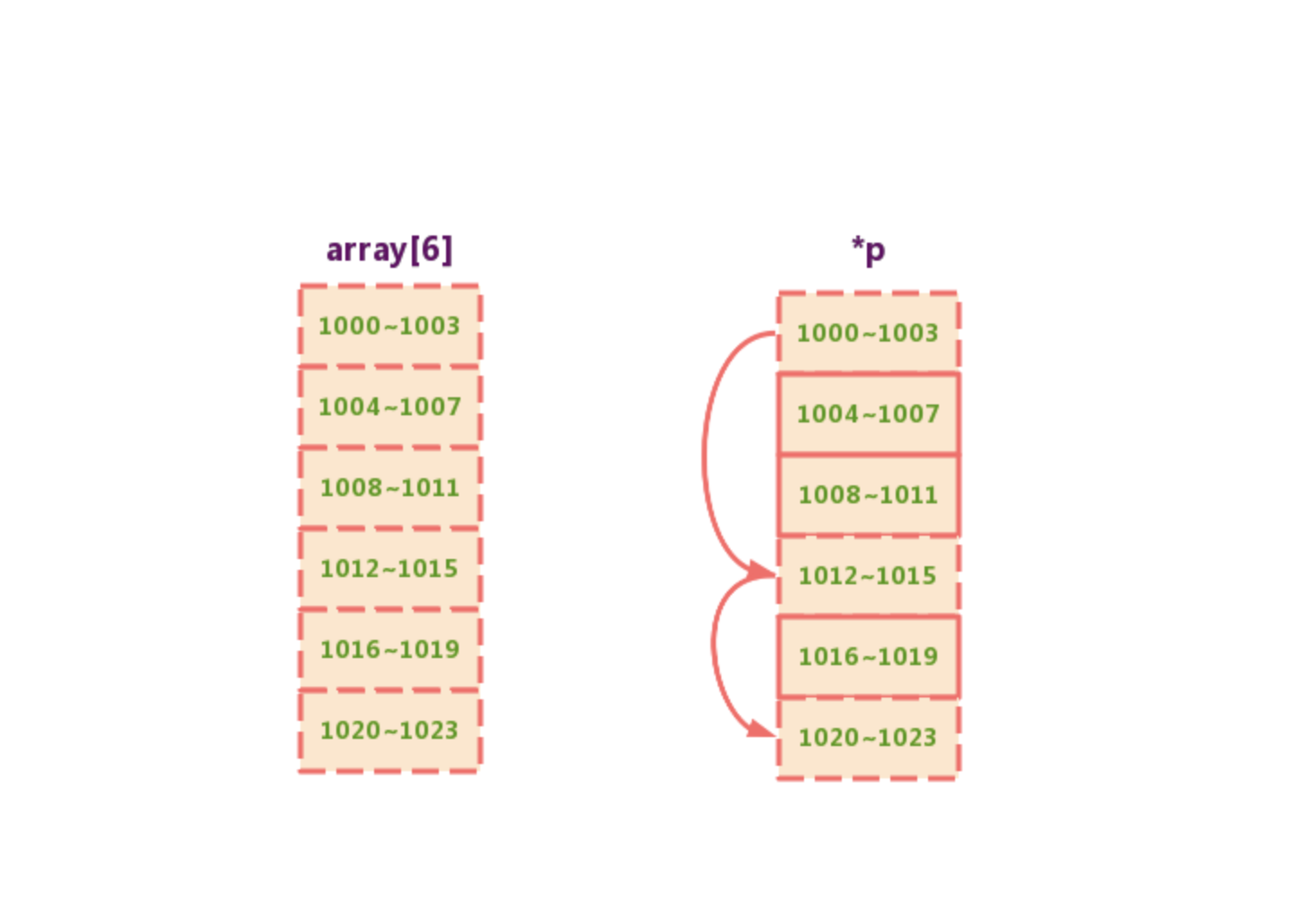
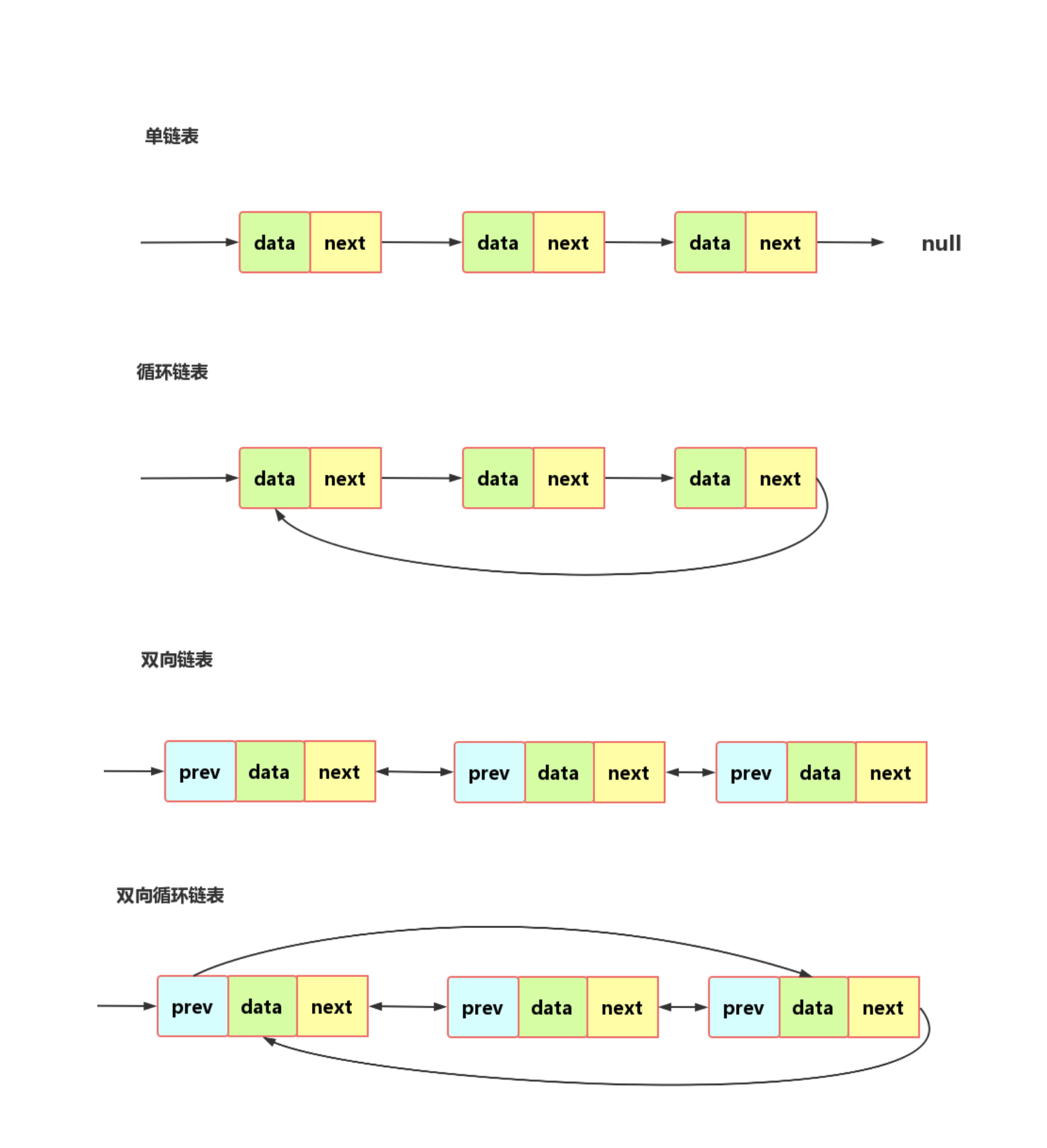
单链表与循环链表
注意链表中的头结点和尾结点。
循环链表从尾可以方便的到头,适合环型结构数据,比如约瑟夫问题。
双向链表
优势:
O(1) 时间复杂度找到前驱结点
删除,插入更高效。考虑以下两种情况:
- 删除结点中“值等于某个给定值”的结点
- 删除给定指针指向的结点
查询更高效:记录上次查找的位置 p,每次查询时,根据要查找的值与 p 的大小关系,决定是往前还是往后查找,所以平均只需要查找一半的数据。
再次比较数组和链表
从复杂度分析:
| 时间复杂度 | 数组 | 链表 |
|---|---|---|
| 插入删除 | O(n) | O(1) |
| 随机访问 | O(1) | O(n) |
其它角度:
-
内存连续,利用 CPU 的缓存机制,预读数组中的数据,所以访问效率更高。
-
而链表在内存中并不是连续存储,所以对 CPU 缓存不友好,没办法有效预读。
-
数组的大小固定,即使动态申请,也需要拷贝数据,费时费力。
-
链表支持动态扩容.
class SinglyLinkedList:
def __init__(self) -> None:
self.head = None
def insert_tail(self, value):
if self.head is None:
self.insert_to_head(value)
return
q = self.head
# 寻找尾结点
while q.next is not None:
q = q.next
new_node = self.Node(value)
q.next = new_node
def insert_to_head(self, value):
new_node = self.Node(value)
if self.head is None:
self.head = new_node
else:
new_node.next = self.head
self.head = new_node
def delete_by_value(self, value):
if self.head is None:
return False
q = self.head
p = None
while q is not None and q.data != value:
p = q
q = q.next
# 当链表中没有 value 的时候
if q is None:
return False
# head 的值就是 value 的时候
if p is None:
self.head = self.head.next
else:
p.next = q.next
return True
def find_by_value(self, value):
if self.head is None:
return
q = self.head
while q is not None and q.data != value:
q = q.next
if q is None:
return
return q
def insert_after(self, node, value):
if node is None:
return
new_node = self.Node(value)
new_node.next = node.next
node.next = new_node
def insert_before(self, node, value):
if self.head is None:
self.insert_to_head(value)
return
q = self.head
while q is not None and q.next != node:
q = q.next
# 链表中,没有一个与 node 相等的结点
if q is None:
return
new_node = self.Node(value)
new_node.next = node
q.next = new_node
def print_all(self):
if self.head is None:
return
q = self.head
while q is not None:
print(q.data)
q = q.next
class Node:
def __init__(self, data) -> None:
self.data = data
self.next = None
def test_link():
link = SinglyLinkedList()
data = [1, 2, 5, 3, 1]
for i in data:
link.insert_tail(i)
link.insert_to_head(99)
# 打印内容为 99 1 2 5 3 1
link.print_all()
link.delete_by_value(2)
assert not link.delete_by_value(999)
assert link.delete_by_value(99)
# 打印内容为 1 5 3 1
link.print_all()
assert link.find_by_value(2) is None
new_node = link.find_by_value(3)
link.insert_after(new_node, 10)
assert link.find_by_value(3).next.data == 10
link.insert_before(new_node, 30)
assert link.find_by_value(5).next.data == 30
if __name__ == '__main__':
test_link()
public class SinglyLinkedList {
Node head;
public void insertTail(int value) {
if (head == null) {
insertToHead(value);
return;
}
Node q = head;
while (q.next != null) {
q = q.next;
}
Node newNode = new Node(value);
q.next = newNode;
}
public void insertToHead(int value) {
Node newNode = new Node(value);
newNode.next = head;
head = newNode;
}
public boolean deleteByValue(int value) {
if (head == null)
return false;
Node p = head;
Node q = null;
while (p != null && p.data != value) {
q = p;
p = p.next;
}
// 链表中,没有 value
if (p == null)
return false;
// 数据在 head 上
if (q == null) {
head = head.next;
} else {
q.next = p.next;
}
return true;
}
public Node findByValue(int value) {
if (head == null)
return null;
Node q = head;
while (q != null && q.data != value) {
q = q.next;
}
if (q == null)
return null;
return q;
}
public void insertAfter(Node node, int value) {
if (node == null)
return;
Node newNode = new Node(value);
newNode.next = node.next;
node.next = newNode;
}
public void insertBefore(Node node, int value) {
if (node == null)
return;
if (head == null) {
insertToHead(value);
} else {
Node q = head;
while (q != null && q.next != node) {
q = q.next;
}
if (q == null)
return;
Node newNode = new Node(value);
newNode.next = q.next;
q.next = newNode;
}
}
public void printAll() {
if (head == null)
return;
Node q = head;
while (q != null) {
System.out.print(q.data + " ");
q = q.next;
}
System.out.println();
}
public static class Node {
int data;
Node next;
public Node(int data) {
this.data = data;
}
}
public static void main(String[] args) {
SinglyLinkedList link = new SinglyLinkedList();
int data[] = { 1, 2, 5, 3, 1 };
for (int i = 0; i < data.length; i++) {
link.insertTail(data[i]);
}
link.insertToHead(99);
// 打印内容为 99 1 2 5 3 1
link.printAll();
link.deleteByValue(2);
System.out.println(!link.deleteByValue(999));
System.out.println(link.deleteByValue(99));
// 打印内容为 1 5 3 1
link.printAll();
System.out.println(link.findByValue(2) == null);
Node newNode = link.findByValue(3);
link.insertAfter(newNode, 10);
System.out.println(link.findByValue(3).next.data == 10);
link.insertBefore(newNode, 30);
System.out.println(link.findByValue(5).next.data == 30);
}
}
11-6 二叉树
课程贴:https://ceshiren.com/t/topic/11728
树的基本术语
父节点,子节点: A 和B
兄弟节点:D E J
根节点:A
叶节点:G I

-
节点高度:节点到叶节点的最长路径(边数)
-
节点深度:根节点到这节点所经历的边的个数
-
节点的层数:节点的深度 + 1
-
树高度:根节点的高度

-
节点的高度:一个人量身体各部位长度,从脚下拉尺到各部位(腿长)
-
节点深度:量水中物品的深度,从水面拉尺到水中的宝藏
-
节点的层数:尺子从 1 开始计数
-
树高度:头到脚的高度
二叉树
最多有两个叉的树。
满二叉树:叶子节点全在最底层,除了叶子节点之外,每个节点都有左右两个子节点。
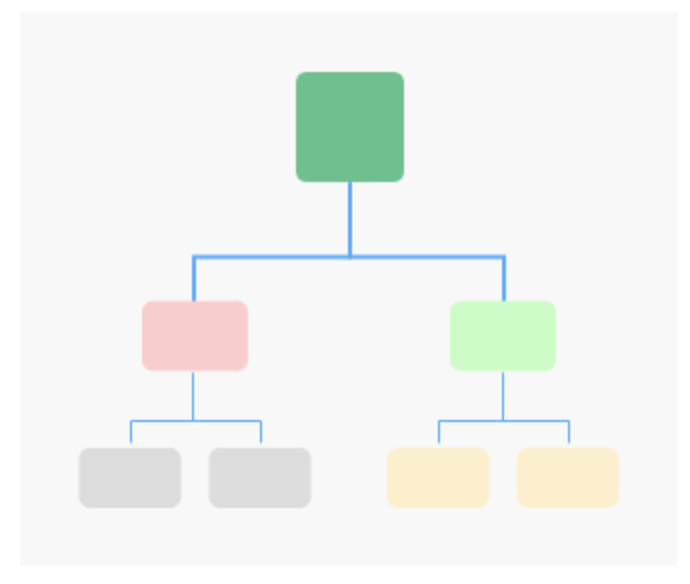
完全二叉树:叶子节点都在最底下两层,最后一层的叶子节点都靠左排列,并且除了最后一层,其他层的节点个数都要达到最大。
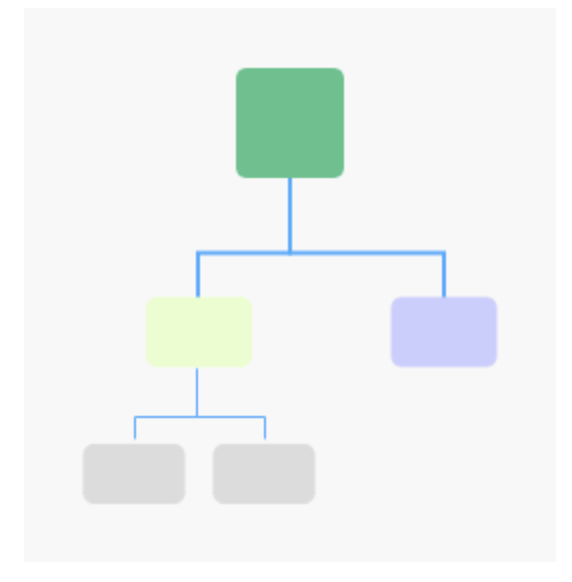
满二叉树和完全二叉树的意义是什么?
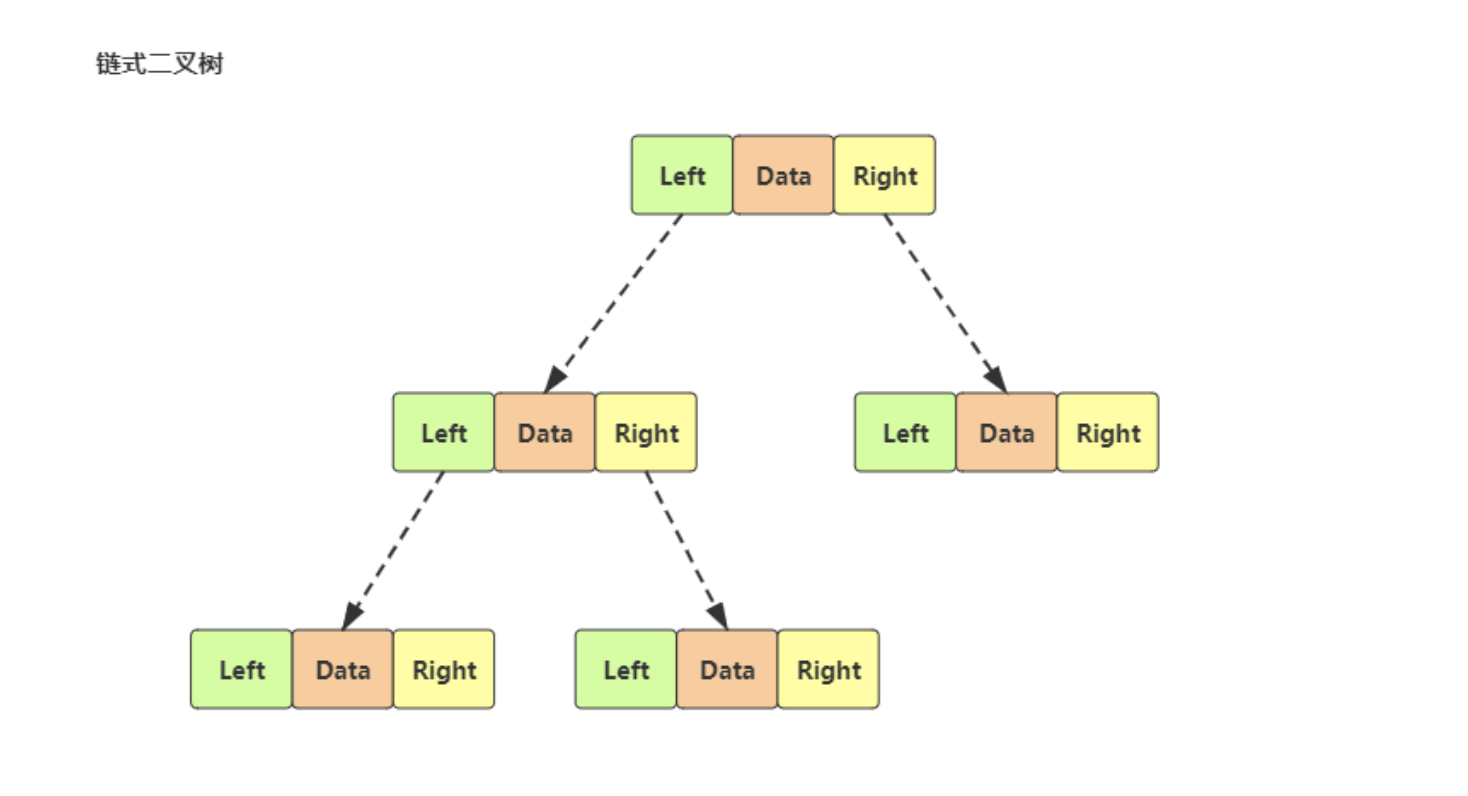
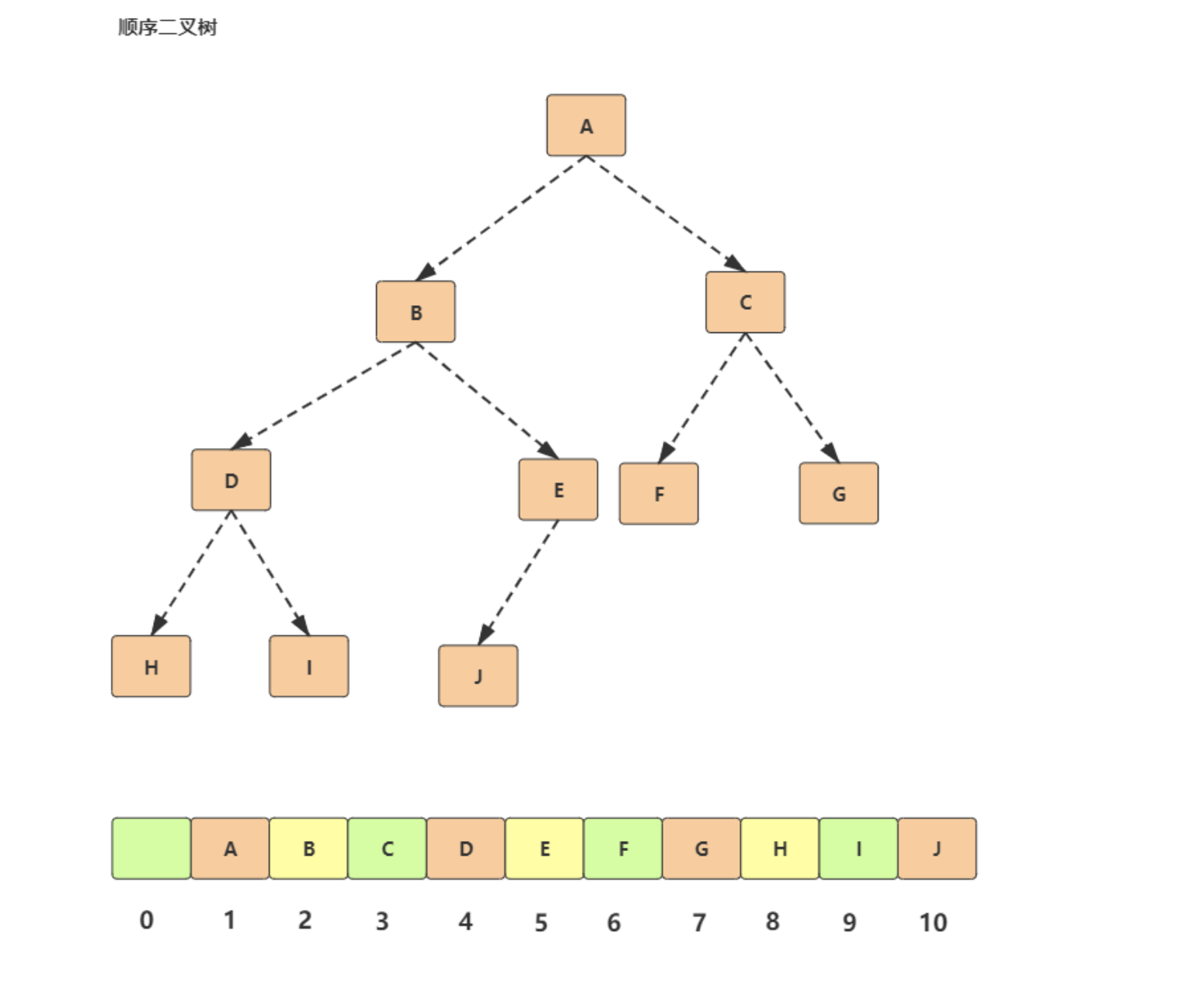
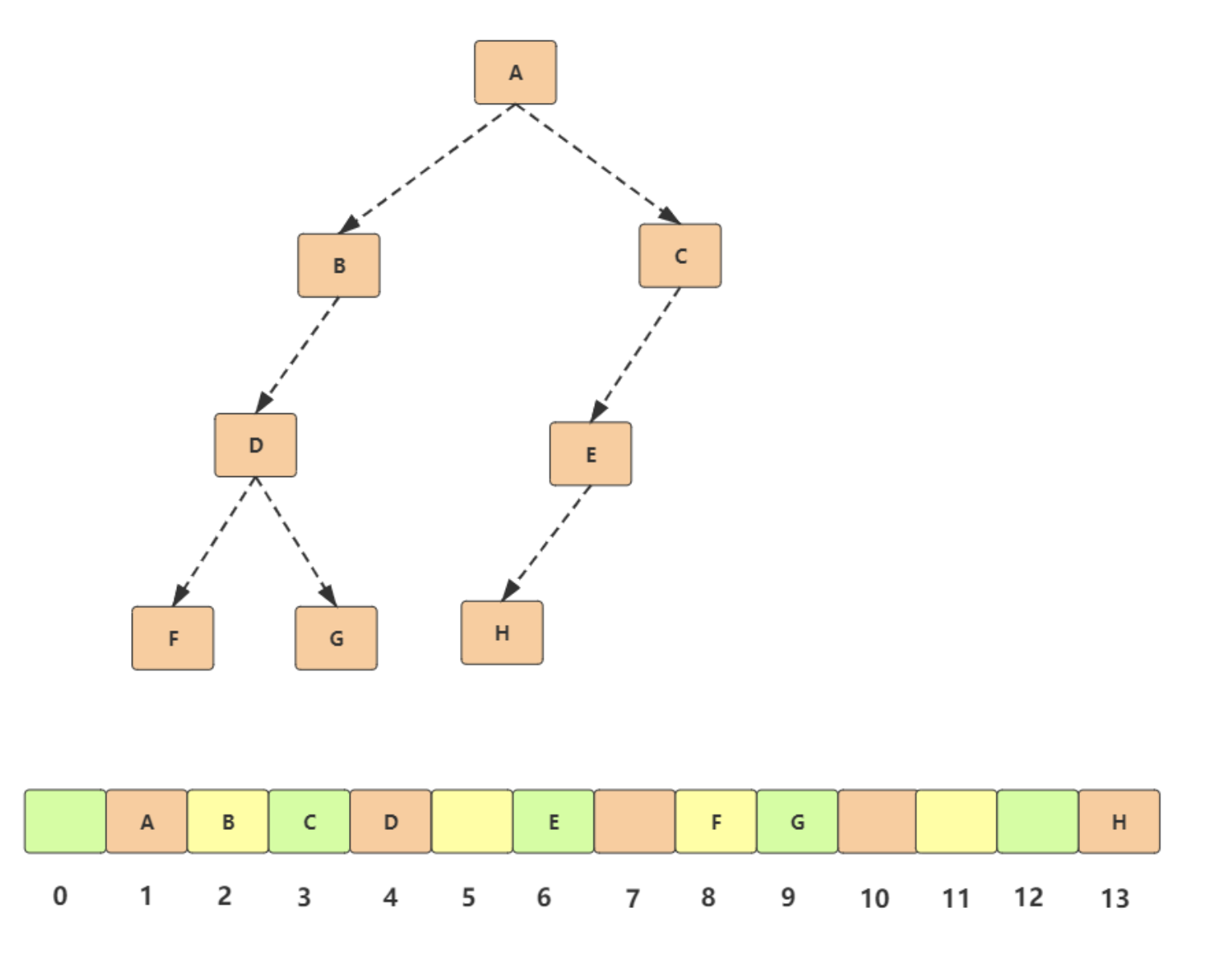
- 节点 X 在数组下标 i
- 左子节点:2 * i
- 右子节点:2 * i + 1
- 父节点:i/2
二叉树的遍历
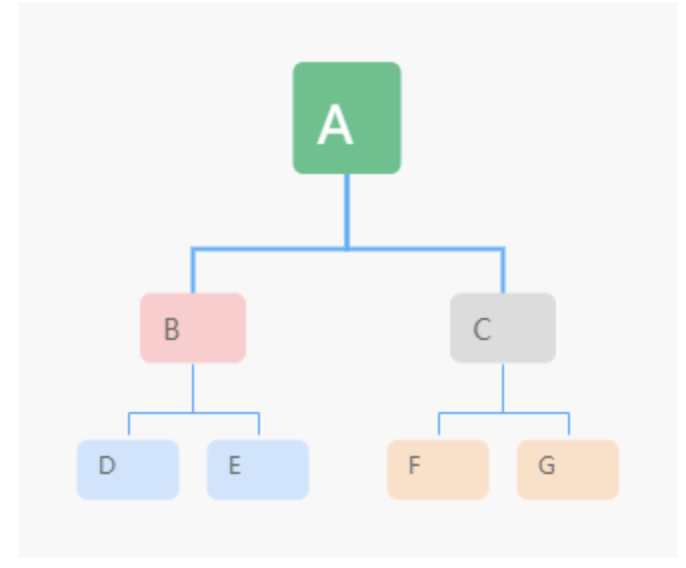
根据节点打印的顺序分前,中,后。比如:
- 前序遍历:节点 → 左子树 → 右子树。A->B->D->E->C->F->G
- 中序遍历:左子树 → 节点 → 右子树。D->B->E->A->F->C->G
- 后序遍历:左子树 → 右子树 → 节点。D->E->B->F->G->C->A
递推关系式:
前序遍历的递推公式:
preOrder(r) = print r->preOrder(r->left)->preOrder(r->right)
中序遍历的递推公式:
inOrder(r) = inOrder(r->left)->print r->inOrder(r->right)
后序遍历的递推公式:
postOrder(r) = postOrder(r->left)->postOrder(r->right)->print r
代码:
void preOrder(Node* root) {
if (root == null) return;
print root // 此处为伪代码,表示打印root节点
preOrder(root->left);
preOrder(root->right);
}
void inOrder(Node* root) {
if (root == null) return;
inOrder(root->left);
print root // 此处为伪代码,表示打印root节点
inOrder(root->right);
}
void postOrder(Node* root) {
if (root == null) return;
postOrder(root->left);
postOrder(root->right);
print root // 此处为伪代码,表示打印root节点
}
复杂度:
O(n):遍历操作的时间复杂度,跟节点的个数 n 成正比
二叉查找树
左子树每个节点的值,都要小于这个节点的值,而右子树节点的值都大于这个节点的值。
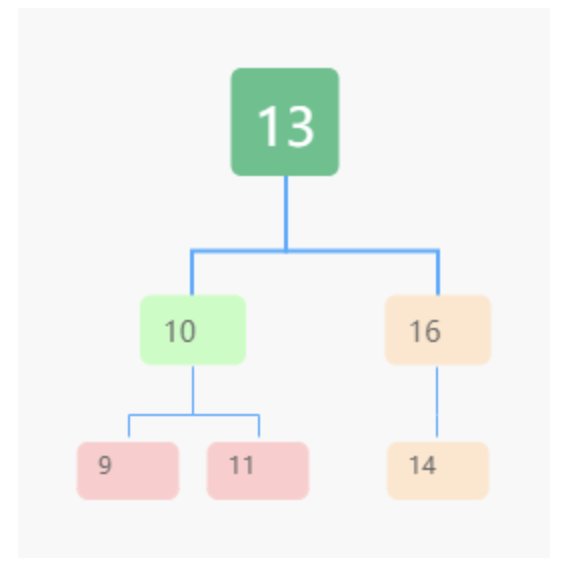
查找
根节点
- 比之小> 左子树中递归查找。
- 比之大> 右子树中递归查找。
插入
- 从根节点开始比较,如果比之大,并且节点右子树为空,就将新数据插到右子节点;
- 如果不为空,就再递归遍历右子树,查找插入位置。
- 如果要插入的数据比节点数值小,并且节点的左子树为空,就将新数据插入到左子节点的位置。
- 如果不为空,就再递归遍历左子树,查找插入位置。

删除
情况一:要删除的节点没有子节点
只需要直接将父节点中,指向要删除节点的指针置为 null。比如图中的删除节点 55。
情况二:如果要删除的节点只有一个子节点(只有左子节点或者右子节点),
只需要更新父节点中,指向要删除节点的指针,让它指向要删除节点的子节点就可以了。比如图中的删除节点 13。
情况三:如果要删除的节点有两个子节点
-
找到这个节点的右子树中的最小节点,把它替换到要删除的节点上。
-
然后再删除掉这个最小节点,因为最小节点肯定没有左子节点(如果有左子结点,那就不是最小节点了),所以,我们可以应用上面两条规则来删除这个最小节点。比如图中的删除节点 18。
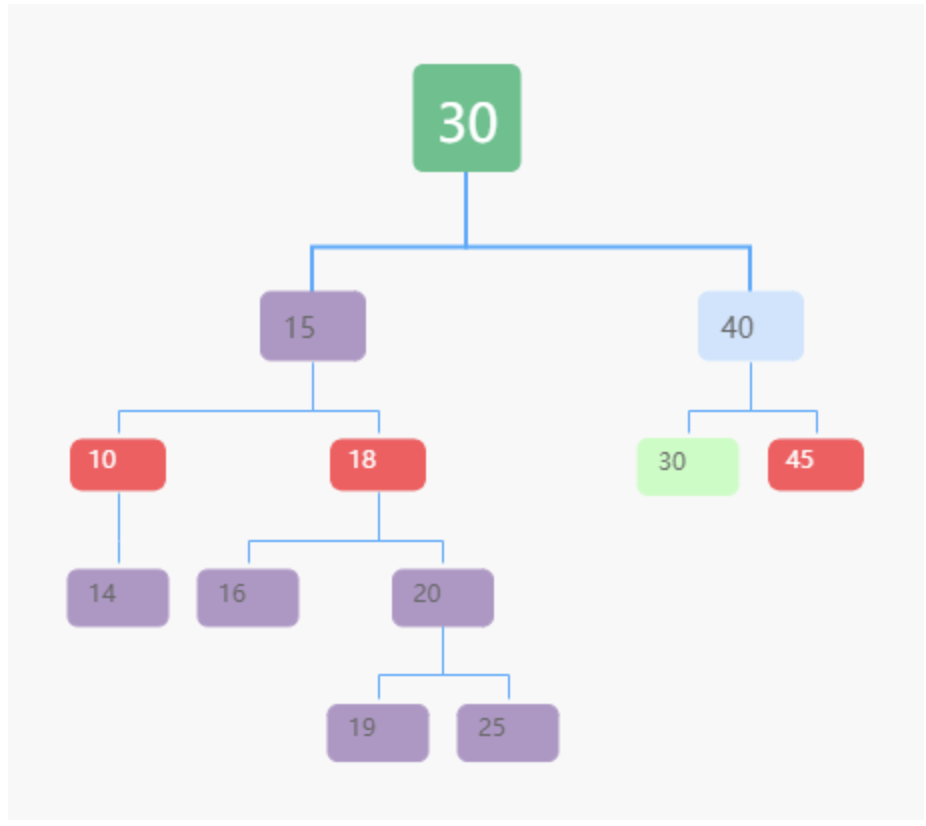

取巧方法:将要删除的节点标记为“已删除”。
重要特性
中序遍历二叉查找树,可以得到有序的数据序列,时间复杂度是 O(n)。因此,二叉查找树又称二叉排序树。
class BinarySearchTree:
def __init__(self) -> None:
self.tree = None
class Node:
def __init__(self, data) -> None:
self.data = data
self.left = None
self.right = None
def insert(self, value):
# 如果是根结点,直接插入
if self.tree is None:
self.tree = self.Node(value)
return
p = self.tree
while p is not None:
if value > p.data:
if p.right is None:
p.right = self.Node(value)
return
p = p.right
elif value < p.data:
if p.left is None:
p.left = self.Node(value)
return
p = p.left
def find(self, value):
p = self.tree
while p is not None:
if value > p.data:
p = p.right
elif value < p.data:
p = p.left
else:
return p
return None
def delete(self, value):
p = self.tree
pp = None
while p is not None and p.data != value:
pp = p
if value > p.data:
p = p.right
elif value < p.data:
p = p.left
if p is None:
return
if p.left is not None and p.right is not None:
tmp_p = p.right
tmp_pp = p
# 找要删除结点的右子树中的最小值
while tmp_p.left is not None:
tmp_pp = tmp_p
tmp_p = p.left
p.data = tmp_p.data
p = tmp_p
pp = tmp_pp
if p.left is not None:
child = p.left
elif p.right is not None:
child = p.right
else:
child = None
# 删除根结点
if pp is None:
self.tree = child
elif pp.left is p:
pp.left = child
elif pp.right is p:
pp.right = child
def pre_order(self, node):
if node is None:
return
print(node.data)
self.pre_order(node.left)
self.pre_order(node.right)
def in_order(self, node):
if node is None:
return
self.in_order(node.left)
print(node.data)
self.in_order(node.right)
def post_order(self, node):
if node is None:
return
self.post_order(node.left)
self.post_order(node.right)
print(node.data)
def test_binary_search_tree():
binary_search_tree = BinarySearchTree()
data = [1, 10, 20, 40, 13]
for i in data:
binary_search_tree.insert(i)
assert 20 == binary_search_tree.find(20).data
binary_search_tree.delete(20)
assert binary_search_tree.find(20) is None
# 1 10 40 13
binary_search_tree.pre_order(binary_search_tree.tree)
print("-----------------------")
# 1 10 13 40
binary_search_tree.in_order(binary_search_tree.tree)
print("-----------------------")
# 13 40 10 1
binary_search_tree.post_order(binary_search_tree.tree)
if __name__ == '__main__':
test_binary_search_tree()
最后
以上就是单薄枫叶最近收集整理的关于11 数据结构、算法、设计模式11-1 算法性能评估11-2 数组与列表11-3 队列11-4 堆栈11-5 链表11-6 二叉树的全部内容,更多相关11内容请搜索靠谱客的其他文章。








发表评论 取消回复